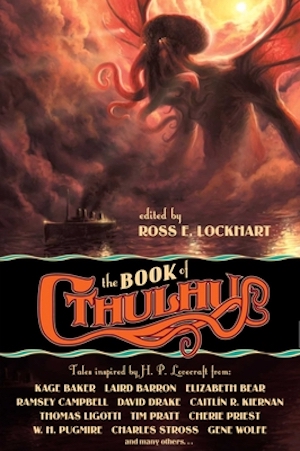Welcome back to Reading the Weird, in which we get girl cooties all over weird fiction, cosmic horror, and Lovecraftiana—from its historical roots through its most recent branches.
This week, we cover Charles R. Saunders’s “Jeroboam Henley’s Debt,” first published in Potboiler in 1982. You can find it most easily in The Book of Cthulhu. Spoilers ahead!
An undergraduate at Howard University, Theotis Nedeau had an “almost obsessive absorption with African culture.” In the early 1900s, Howard students shunned “all things African,” even deriding African students as “Home Boys.” Jeremiah Henley defended his best friend’s interests in private. Theotis, a superb athlete and boxer, had no trouble defending himself in public.
Theotis traveled to the Gold Coast and studied the art of the “ju-ju men,” a term which, like “witch doctor,” he despises—malam is the correct name for practitioners of “the true magic of Africa.” He’s now a history professor at Howard. Jeremiah has moved to Canada, but the two correspond regularly. When Jeremiah calls for help, Theotis answers.
As the moon casts “a wan white glare” on Jeremiah’s house, Theotis parks his new-model 1933 sedan in the driveway. Two incidents marred his drive north. At the border he had to promise he’d remain in Canada only two weeks. The Canadian government discourages “coloured immigration.” During a gas station stop to ask directions for Henleyville, the attendant pulled a gun and deputy’s badge, suspecting Theotis has stolen his own car. Jeremiah recognizes the description: that’d be Lorne Cooder. He won’t be surprised if Cooder pays a visit later.
In the living room, Theotis notices a square of unfaded wallpaper, and asks what happened to the portrait of Jeroboam Henley, Jeremiah’s grandfather. Jeroboam escaped slavery and settled in Ohio, where he ran an Underground Railroad station and assisted fellow escapees seeking sanctuary in Canada. Following passage of the Fugitive Slave Act, Jeroboam emigrated to Canada and founded a “self-contained community of ex-slaves” where he remained until his death.
Jeremiah says he burned Jeroboam’s portrait.
Visibly anxious, Jeremiah explains. Recently he began having nightmares so violent they drove his wife Emma to sleep elsewhere. One night he “dreams” himself compelled to open a hidden door to the long-locked attic. There he finds a leatherbound book recording every fugitive Jeroboam helped. But why are some names crossed out? A shattering answer awaits: the crossed-out names are repeated later with dollar amounts appended. It’s a ledger of the people Jeroboam sold back to a Louisiana plantation owner! This slave-owner wanted only native Africans, a rare “commodity” by 1850 – as sacrifices to a god or devil called Shub-Niggurath.
The last African who Jeroboam sold was Gbomi, a malam who cursed him. Soon after, strange events bedevilled the Ohio town: animals killed and drained of blood, “splayed footprints” leading to Jeroboam’s house. Never-friendly townspeople became actively hostile. Claiming the Fugitive Slave Act as motivation, Jeroboam fled to Canada, but he was really running from Gbomi.
Feeling betrayed, Jeremiah burned Jeroboam’s portrait. His wife, fearing he was insane, left, taking their two sons. Now night-terrors bedevil Henleyville again. Theotis is the only one who can help, because he’s come back!
A brick shatters the window, bearing a message from Cooder: if Jeremiah’s “black friend” has come to take him away, he better do it soon. Grimly Theotis agrees that they have no time to lose. In the attic he lights candles, spreads sand on a tray, pours black powder into a wooden bowl. The two long bones he produces are from a leopard; a powerful malam gave them in exchange for legal assistance. The friends will need all this to combat the semando stalking Jeremiah. This creature is a dead thing shaped and controlled by a malam. It consumes blood to gain strength for its ultimate purpose: vengeance. Now Theotis will summon the semando; the kaliloze powder in his bowl will destroy it.
Jeremiah protests such “savage ceremonies,” but is silenced by a Theotis he’s beginning to fear. The “ceremonies” commence with Theotis chanting, drumming with the bones on the sand in his tray. A crash downstairs interrupts. Footsteps approach with a “squamous, sucking sound”. The attic door bangs open. Jeremiah screams when he sees a “lurching travesty” of a man made of dark mud. Its face is crude, distorted, but still he recognizes Jeroboam.
Buy the Book


A House With Good Bones
Theotis flings the kaliloze powder on the semando. It sloughs away into a viscous puddle of mire and stolen blood. Jeremiah’s relief is short-lived, for not Theotis seizes him by the throat.
“Theotis” explains that in Creole French, Nedeau means “born of water,” which is also what Gbomi means in Yoruba. Gbomi is Theotis’s grandfather, who has possessed his grandson to enact vengeance. Though himself innocent, Jeremiah must pay Jeroboam’s debt. Briefly Jeremiah’s pleas soften Theotis’s features. Then Gbomi takes over again and speaks in a “thick, alien” voice: “Hen-lee…now, you die!”
He snaps Jeremiah’s neck, then calmly leaves, tipping the candles on his way. The Henley house burns like a giant pyre. Before the authorities can respond, Theotis drives off. He remembers the calling-of-the-ancestors rite he performed in Africa, which summoned Gbomi from his Louisiana bayou grave. He remembers killing the grandson of the man who sold Gbomi to a slave-ship captain. Gbomi has taught him that “all generations were part of a single continuum” and so the debts of the forefathers must be borne by their descendants.
He’s heading to Louisiana now to kill the grandson of the slave-owner who sacrificed Gbomi to a god with an unspeakable name. Only then will Gbomi’s “relentless shade” be placated, leaving Theotis all his own again.
For now, “Gbomi would not allow Theotis Nedeau to weep for his friend…”
What’s Cyclopean: Mephitic grave-mud. And then there are those squamous footsteps.
The Degenerate Dutch: Canada welcomed those freeing slavery once—but now that they’ve been settled for a couple of generations and the contrast with the U.S. isn’t so tempting, provides plentiful gun- and n-word-wielding horrors of its own.
Weirdbuilding: Shub-Niggurath doesn’t appear on camera, but is in the background happily chowing down on whoever her plantation-owning worshippers provide—and providing confirmation of the story’s own ancestry. In turn, “Debt” offers an early deconstruction in the line of Lovecraft Country and The Ballad of Black Tom.
Libronomicon: Jeroboam Henley’s diary makes for deeply unpleasant reading.
Madness Takes Its Toll: After Jeremiah burns his grandfather’s portrait and diary, his wife Emma takes the kids and leaves. She thinks he’s crazy.
Ruthanna’s Commentary
We’ve covered any number of stories playing Spot-the-Reference with Lovecraft. I love a good game as much as anyone, and can spend a happy few pages waving hello to obscure-yet-familiar deities, carelessly anthropophagous extraterrestrial entities, and hapless Miskatonic researchers. Saunders is doing something different. Maybe it’s Spot-the-Reference, next level: not so many familiar entities, but familiar themes woven into new patterns. The same conflicts play out very differently depending on who’s experiencing them.
When Lovecraft’s characters suffer from hidden family history, for example, it’s the horror of ancestors who had mental illnesses, or were (gasp) not of pure Anglo-saxon (or human—same thing, right?) descent. Nedeau and Henley, very much not Anglo, have different flavors of challenging kinfolk. And as with Alison, natural and supernatural challenges mesh so closely that it’s hard to tell where one stops and the other begins.
Jeroboam Henley was an underground railroad conductor and the founder of a town of Canadian freedmen that bears his name. He was spoken of in the same breath as Harriet Tubman. His grandson might boast of such ancestry, with more justify his pride than your average rich white fellow of “noble” lineage. But—true horror—it turns out that Jeroboam committed the same sins you’d expect of a heraldic Anglo family, made worse by the betrayal entailed. He quietly sold some of his refugees back into slavery—and into the ultimate expression of being treated like an object rather than a person, the sacrificial altar. This version of Shub-Niggurath has a taste not for virgins but for native Africans, or more likely her slaveholder worshippers preferred such offerings.
He dealt with demons, and came down with a bad case of fatal curse from one those he betrayed. Now said curse is after Jeremiah. (Named for the author of the Book of Lamentations, who warned of the devastation that comes from worshipping idols. Or elder gods, one supposes.) Jeremiah thus has to deal with both the horror of his grandfather’s hidden wickedness, and with being held supernaturally responsible for that wickedness.
And his father, who kept him from the attic, must have known too. Nor does he seem like a pleasant person: the source of things Jeremiah “did not want to remember and never wanted to know.”
Nedeau, on the other hand, has spent his life and career searching for the secrets of the past—despite being surrounded by people who generally found that history mildly distasteful. His Howard classmates wanted to be African-American, not African. Not so Nedeau, who not only studied Africa but went there and participated in ancestral rituals. And… oops, it turns out that there was something to avoid in that ancestry after all. Sorcerer Gbomi is perfectly happy to possess and control his own descendent—taking away his freedom—if it facilitates vengeance on those responsible for his enslavement and death. All generations are “part of a single continuum” and don’t get their own lives as long as the continuum of wrongdoers continues.
In Lovecraft, all the non-white people knowing the truth about the universe is terrifying to the white people. In Saunders, it’s not so great for everyone else, either.
Nedeau and Henley also draw on another Lovecraftian trope: the mutually destructive, mutually enabling homoerotic duo. Nedeau is the stronger half here, both physically and in his personality (now subsumed by another even more powerful will). He’s the one who fights back even when it’s dangerous, who punches racists and calmly faces down gun-toting cops. Henley is the weaker, frightened half, calling on his friend for aid. (And it just now occurs to me that Gbomi must also have possessed him to force his discovery of the diary.) But it’s Henley’s past that has reshaped Nadeau’s life, forcing him into another’s quest for vengeance.
It’s an open question which of them has the worse deal—even if Henley is the one stuck with italicized last words.
Anne’s Commentary
Here we encounter again that Plot as Old as Time (PaOaT), or at least as old as weird tale telling: Friend or colleague or expert arrive at a (usually isolated) house in response to the urgent summons of a friend or colleague or client, and weirdness ensues, leaving somebody dead or insane. By amusing coincidence, the next story in The Book of Cthulhu anthology is Thomas Ligotti’s “Nethescurial.” An archivist is corresponding about a manuscript he’s discovered. It appears to be a letter or journal entry, perhaps unpublished fiction, given its fantastic contents. The “statement” describes Bartholomew Gray’s arrival on a remote northern island inhabited only by an archaeologist, Dr. N. N has unearthed a fragment of an ancient idol worshiped by pantheistic cultists. Learning their Great One God is actually the Great One Demon, Essential Evil, some cultists break the idol into several parts, each hidden on its own isolated island.
Dr. N fears surviving cultists are after him. He’s right, of course. Gray, summoned to help keep the idol-bits separate, is in fact a cultist toting the other bits in his suitcase. He reassembles Nethescurial, sacrifices Dr. N to It; then, having experienced shattering revelations of the PanDemon’s nature, he destroys the idol again and throws the pieces into the sea.
In my Kindle version of The Book of Cthulhu, Ligotti’s story is missing from the table of contents—“Jeroboam” is followed by Kage Baker’s “Calamari Curls.” If I hadn’t swiped from the last page of “Jeroboam” to the next (which proved to be the start of “Nethescurial”)—if I hadn’t idly continued reading—! Well. Then I wouldn’t have found the archivist’s wry comment that in the manuscript, “the drama enacted is a familiar one,” the characters “puppets from the old shows, the ones that have told the same story for centuries.” He adds this redeeming line, that the “old shows” can “still be very strange to us.”
I interpret that “very strange” to mean the “familiar dramas” and “puppets” can still thrill and move, which was my experience with “Jeroboam Henley’s Debt.” Starting it, I immediately recognized the trademark set-ups and flourishes of a PaOaT (Subspecies: Character Summoned to Isolated/Old/Creepy House, Weirdness Ensuing.) “Jeroboam,” I smile to find, was first published in the Canadian fanzine Potboiler #4,1982. The point of view, with head-hops from Theotis to Jeremiah interspersed with omniscient-narratorial exposition, struck me as a bit clunky but efficient for a tale this short yet packed with essential backstories. Or as Gbomi taught his grandson, “All generations were part of a single continuum, ancestors and descendants all as one,” their fates inextricably linked for good and bad alike.
Similarly, details I shrugged off as overexpected tropelets proved on closer examination to be vivid, novel, pregnant with significance. Instead of the fog blanketing most Isolated/Old/Creepy Houses and their environs, Saunders gives us a house and trees moon-limned in a “wan white glare.” Spotlighted as it were, as will be the sins of Jeremiah’s forefathers, the injustices suffered by Theotis’s. The motor of Theotis’s 1933 Auburn sedan shuts down with “the growl of an impatient beast,” the sort I imagine Gbomi is making inside his possessed grandson. That Theotis drives a shiny new car is emblematic of the status white people refuse to grant a Black man. Both in college and traveling to Henleyville, Theotis gets in trouble over his car, his to-the-whites intolerable wealth. Jeroboam and Jeremiah similarly irritate white neighbors by living in big houses. That there’s a whole town named after Jeroboam Henley must further enrage guys like Lorne Cooder.
When a writer deftly balances fantastic horrors with real-world ones, the story’s scare-power rises for me, along with its long-term resonance. We could argue that imagined monsters are implicitly stand-ins, fictionalizations, that make human evil safer to read about—that reassure us, “Oh, this is made up, it couldn’t really happen.” The deft balance that Saunders achieves refuses to cloak real horrors in fantasy, to grant the easy-out of “couldn’t really happen.” Slavery did happen, and segregation and race hatred did happen. Do happen. And even the justice that supernatural avengers can provide may be tainted. Must be tainted? Why must Jeremiah pay Jeroboam’s debt? Why must Theotis enact Gbomi’s revenge on his own best friend, and then not be allowed even to weep over his loss?
The way of the malam is hard.
Also a problem is the name of the entity to which the plantation-owner sacrificed betrayed Africans. Were the second and third syllables of Shub-Niggurath intended to be a slur? Jeremiah and Theotis take it as one. Jeremiah assumes Jeroboam didn’t resent the demon’s name because he sent trusting fugitives back into slavery and thus (figuratively?) into Shub’s maw. For money! And yet Jeroboam’s diary hints he was coerced. And yet, what about all the fugitives Jeroboam did save? How much should the good weigh against the evil? If at all.
Again. The way of the malam is hard.
Next week, join us for Chapter 4 of Hilary Mantel’s Beyond Black.
Ruthanna Emrys’s A Half-Built Garden is now out! She is also the author of the Innsmouth Legacy series, including Winter Tide and Deep Roots. You can find some of her fiction, weird and otherwise, on Tor.com, most recently “The Word of Flesh and Soul.” Ruthanna is online on Twitter and Patreon, and offline in a mysterious manor house with her large, chaotic, multi-species household outside Washington DC.
Anne M. Pillsworth’s short story “The Madonna of the Abattoir” appears on Tor.com. Her young adult Mythos novel, Summoned, is available from Tor Teen along with sequel Fathomless. She lives in Edgewood, a Victorian trolley car suburb of Providence, Rhode Island, uncomfortably near Joseph Curwen’s underground laboratory.














